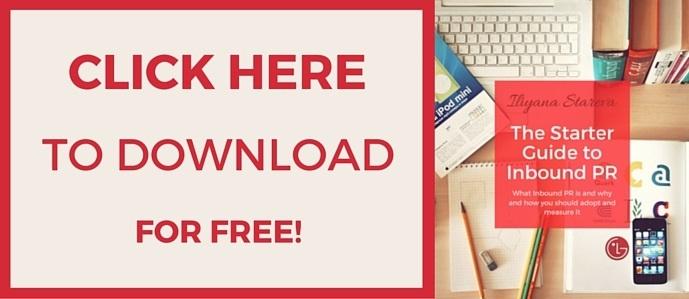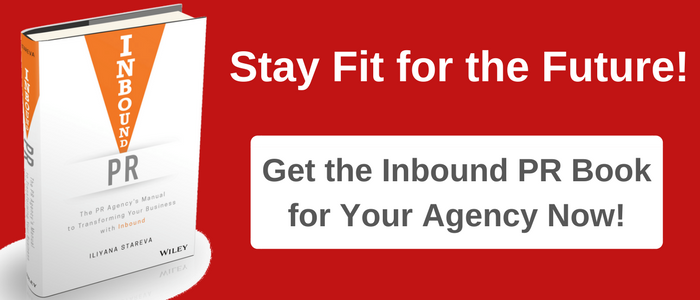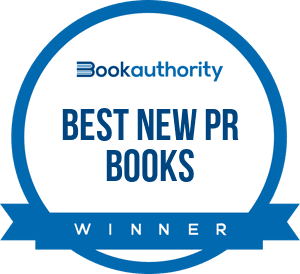
The Inbound PR concept is now one year old. Happy birthday to my concept! (Tomorrow is the day!)
As we've defined before, Inbound PR combines the best of two worlds − public relations and inbound marketing − and alleviates PR's biggest weakness (measurement) and inbound marketing's biggest challenge (content).
One year deserves a proper celebration so I decided it's time for a monster blog posts of 2,800 words that digs a little deeper into the fundamental principles, tools and tactics of Inbound PR and provides multiple tips.
For that, I thought I'd use the alphabet since becoming one year old is a good time to start learning the letters and put the basis in place.
Here we go!
The ABCs of Inbound PR:
A - Attract
Attract is the very first stage of the inbound methodology. Everything starts here − a consumer's journey, a client's discovery, a journalist's search, a blogger's experience. It's all based on how we make decisions today which is fundamentally different than a few decades ago simply because technology has given us so much choice and power as regular people. With Inbound PR, you need to very well know all stakeholders in your business and define where and how their attract stage begins so that you can turn them from strangers into visitors and readers of your content, and ultimately into paying customers or media people you end up working with on a story.
B - Buyer Persona
The most central aspect of all inbound, whether Inbound PR, inbound marketing or inbound sales, is the buyer persona. Nothing works well without a clear definition of your buyer persona or when we speak about media relations of your media persona. The buyer persona is a semi-fictional representation of your ideal customer; it's that deep dive into the problems, needs and questions that your potential customers or good media contacts are asking before they make a decision to buy from you or work with you. You need to know this in and out. If you don't, you won't be able to succeed at any of the steps of the inbound methodology nor will you be able to create relevant content (see next letter).
C - Content
Content is at the centre of both Inbound PR and inbound marketing. It's the one thing that PR people excel at far more than any other professionals out there. Content creation here includes things like blog posts, press releases, special content offers like ebooks, reports or whitepapers. All these allow you to enhance your reputation, build your expertise and here we come back again to the attract part, people will come to you because you create relevant content, the media will come to you too. And this is all inbound. It's pulling people in with blogs who you then convert into leads with relevant content offers and then close as customers with a targeted sales approach that is still supported by good content.
D - Delight
Delight is the last stage of the inbound methodology and is the one that is being most ignored although it really shouldn't be. It's also the one that PR can have a tremendous impact on because it's all about maintaining and enhancing relationships with existing publics, e.g. customer engagement on social or via email with relevant content; the same goes for the media or bloggers you've already cooperated with. Why is this so important? Because acquiring new customers is generally a lot more expensive than retaining existing ones. See some numbers here.
E - Email
A highly ignored or poorly done tactic in communications is email. That's a shame because it has such big potential, especially when we are talking about PR combining forces with email. According to recent research, email is the most effective tactic for lead generation and it's not that hard to implement. Because PR people understand audiences so well and are great content creators, they are well suited to craft good emails. Email is not only a must in the close stage of the inbound methodology but also in delight because you can continue engaging with existing customers or the media with personalised emails and content that truly add value.
F - Facts
Give me the facts − often what journalists want. Often what customers want, too. And often what works really well for content offers when you create reports with the results of a study or research you have done for your client or your business and industry. Because we love data on such a deep level and we always need the latest, people will be interested to hear your facts. The media will too. So use data and facts wisely in your content and throughout all paid, earned, shared and owned (PESO) channels.
G - Google
You better not ignore Google in your Inbound PR efforts. It seems that SEO has escaped the realms of PR professionals but with Inbound PR you simply cannot leave it out. Because for attract to work, for you to be found, you have to understand how Google works and ranks content and then you have to create a relevant keywords strategy based on what your buyer or media personas search for, then create the content, and then optimise the entire website with technical SEO. None of the rest around Inbound PR will work if you don't do this.
H - History
So many PR or marketing professionals start working with a new client or on a new campaign and approach everything completely anew, forgetting to do some research and analysis into the past first. The same thing happens as the client engagement or the campaign continues − three months in and no one looks into what happened during that time, but rather focuses on creating a brand new content strategy and some fresh, new ideas. No, don't do that. Make your decisions based on past performance, look at the data. Also, there's probably plenty of existing content that can be refreshed, repurposed, improved or updated instead of always having to spend so much time creating something from scratch. Define your efforts based on what's done in the past, what's worked and what hasn't.
I - Inclusion
People like to feel as part of something; they like to give and be involved. So give them that, they'll be grateful, they'll reward you with some WOM. Include others in the conversation on social or co-create stories and content for your next campaigns. People also want to hear from others like them. So get your case studies going, put some videos with customers, and include people in your storytelling. It's real life that matters with inbound.
J - Journalists
You can't ignore media relations but PR is not only media relations. Inbound PR focuses far more on all other channels than just earned. Still, earned plays a huge role, but the way to achieve it has changed. Journalists now act just as any other customers. You can entirely use the inbound methodology to attract and engage them and to secure a media placement in a far more personal and customised way than just a cold email or phone pitch. I call this doing media relations the inbound way.
K - Knowledge
You are going to have to know your industry or your client's industry pretty well. That's not only essential so that you can develop the buyer or media personas, it's important because you need to develop some business acumen to properly advise and achieve real ROI that affects the bottom line. Knowledge in this case also includes being able to more than just write. PR pros, I know you hate maths, but sorry, you won't survive unless you acquire those broader business skills.
L - Listening
One thing I don't see PR people do enough is listening. Just shut up and listen. Listen more. Listen on social, listen when reading blogs or newspaper, listen when you are at events, listen when in meetings. Listening gets you to learn, to get to know the audience, the client, the media. It's how you then make informed decisions and how you build relationships. By listening and showing real interest. And then by doing an outreach in a personalised manner or advising correctly. Listening is all about diagnosing before prescribing. Don't skip this step.
M - Measurement
Oh dear measurement, PR's biggest challenge! Anyone who works in PR hears this multiple times a day. The issue with not being able to properly measure PR has been around probably since PR has existed. But with Inbound PR, that goes away. With digital in general, you should be able to measure any activity from all paid, earned, shared and owned media and tie it back to your investment, time and efforts. You just have to connect the dots and do everything according to the goals you've defined in the beginning and bring all measurement back to that.
N - Newsroom
Companies really should start utilising their websites better. Here, I'm not only talking about lead generation and blogging but also about creating an Inbound PR Newsroom that serves the media well. Not only have consumers changed, but so have journalists and bloggers or YouTubers. The way they prepare a story is different. They now do their own extensive research online and on social, just as consumers do. They will find your website and poke around. Even if you've pitched something and they haven't found you on their own, they will still check out that website. So why don't you make it easy for them to get the information they need? That's so easy to do − get a newsroom on your site and put press releases, relevant downloads, interviews, and whatever materials your media persona would benefit from on it. They'll be grateful because you are saving them time.
O - Offer
Get creative with your offers that you put on landing pages to convert people or the media. We spoke about facts, research and reports. Yes, those are great, but what else? How about some videos or webinars? Hidden livestreaming? Some infographics or templates? There's so much storytelling you can do with different formats than just text. People get bored when they are offered the same thing again and again. Attract and engage them in a better way, let them not get bored.
P - Planning
You better know what you are doing. You can't achieve your goals without a solid plan. Because planning is about choosing the right tactics, methods, timelines, responsibilities and roles in order to achieve your goals. It basically means deciding how to get where you want to be. Consider all possible avenues and make a detailed plan that describes your daily, weekly and monthly tactics and to-dos, which PESO channels you'll use, what content needs to be created (and by whom) or repurposed, and then published and distributed, promoted and worked on with the media. The biggest piece of advice with Inbound PR is: Don’t rush in before you know what you are doing. You can always adjust and adapt, and you should, but don't just do something for the sake of doing something.
Q - Quality
Yes, you need a lot of content to rank on Google, generate leads or attract the media, but it's not just about the quantity. Your content needs to be relevant, meaningful, helpful, value-adding and informative. This is more about quality than quantity, not only in terms of your communications, but also the relationships that you are building and the leads you are generating. One quality lead with potential to turn into a customer is better than 10 who never will. It’s the quality of your content and your conversations that matter, not the number.
R - ROI
The most favourite corporate buzzword ROI! Goes back to measurement. So to repeat, PR has never really been able to tie its activities back to the bottom line. With inbound, that's possible. Because PR really can and does drive sales! You just have to demonstrate it which is possible with a methodology such as the inbound one and the help of some software. Check out more on that in this blog post I wrote with an example on how to measure Inbound PR.
S - Social Media
I think we are sort of past the stage where every business was doubting the need to be on social. The issue that we are facing now, though, is that social is not really done correctly or efficiently enough. But social media is essential for every stage of the inbound methodology. You need it to attract people to your content, you can use it to communicate with journalists and close a "story deal", you should be leveraging it to continue delighting existing customers, clients or bloggers you've worked with. You can only be successful at this if you commit the time. I mean a lot of time, not just ad hoc activities here and there. You need to be consistent and tie social media into the bigger picture.
T - Transparency
As I've said before, transparency is the fuel of influence. It’s the fuel of trust. It’s the fuel of relationships. It’s the key to inbound relationships. It's the one things that would ensure you don't end up in a situation where you'll need some serious crisis management. Transparency prompts companies to stop hiding behind the true agenda; admit shortcomings, be honest, fair and so appear human, appear real. This is super important because people want to do business with real people. You work in PR, i.e. you build relations with publics − you can't do that if people don't trust you.
U - Understanding
To succeed with Inbound PR, you'll need to have a deep understanding of the inbound methodology in order to connect the dots. The same goes for the PESO model and how Inbound PR fits in there. I urge you to do as much learning as possible around all those concepts in order to see the bigger picture and only then to start applying it to your business (first step is to do the free Inbound Certification here). Without this basic understanding of all fundamentals, you won't be able to leverage Inbound PR to its full potential.
V - Value
Everything you do with Inbound PR has to provide value. That's why it's called inbound − it draws people in because your content is useful, helpful, informative, fun, cool, creative, innovative or whatever. It adds value to that person, that customer, that client, that blogger or that media representative. It's not about you, it's about them, i.e. WIIFM. Do everything with this thought in mind.
W - Workflows
Workflows are the mother of automation for PR people who have such busy schedules already. Stop doing things manually; define the goals, establish the strategy, create the plan, the content and the assets and then let the software do the work. It doesn't have to be HubSpot from the start (although it's great!); you can go with Google Analytics, Facebook Insights, Mailchimp etc. I suggest you take a look at #PRstack to get you started.
X - X-Ray
In our digitally driven world, nothing stays hidden – people can explode on social, they can freely express their opinions on their own blog or on Medium and LinkedIn. That's why as PR advisers we need to ensure that words are aligned with actions. It's this integrity that builds and guards a company reputation as well as fosters people to come to us and trust us. Because they will put you under the radar; they will "x-ray" you. This is how we make decisions today – we go on Google when we have a problem, we search for it, we read peer blogs or social posts, we examine company's websites, blogs and social media presences, we compare and only then do we make a decision. We don't even need to speak to a sales person from a company. We as consumers have the power, not businesses. You better ensure that your online presence can handle that x-ray.
Y - YouTube
Video content is booming. Just think about how much effort Facebook is putting into it, and so is Twitter, Snapchat, Instagram and all the rest. But YouTube still remains the second biggest search engine so SEO can be big here. And let's not forget all YouTubers you should be engaging with for cooperations or campaigns. Leverage your own video materials but also make sure you are part of others' videos. Here's where some earned would work wonders for you.
Z - Zen
As per definition, Zen emphasizes rigorous meditation-practice, insight into Buddha-nature, and the personal expression of this insight in daily life, especially for the benefit of others. This is how inbound PR should be too - it's not about you, it's about them: your clients, your or their customers, the media, bloggers, YouTubers and each and every public you are involved with. All the content you create and the touchpoints you develop are for the benefit of each of those publics. Otherwise, it won't attract, and if you don't attract, you cannot move to close, convert or delight.
How do you like the Inbound PR alphabet?
Want to get started with Inbound PR? Then get your Inbound PR Starter Guide now! Just click on the image below:








